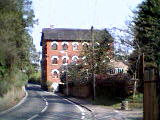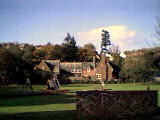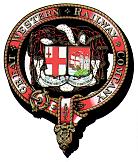
|

|
| The Village Inn | Lower Exwick, Mills etc.. |
| Flood Relief Scheme | The river and the flood relief scheme |
| The Cowley Bridge Inn | Cowley Bridge |
| Brief history of St Davids | St Davids development |
| The Pubs in Station Square | The Pubs and Station area |
| The Imperial | The house, New North Road, Buller, Hele Road. |
| The Northbridge Inn | Upper St Davids Hill, the Packhorse Inn |
| Use the text links for more information! |
No sidebar menus?, Click Here and re-select |
|
|
Depending upon whose bed, floor or gutter you wake up in, you'll find yourself either on the west or the
east side of the river. Those on the west side start at the Village Inn in Exwick, alternatively start in
the St Davids' Station Square area if you're closer. In 1086 this part of town was known as
Essoic, and in 1244 Exewyke. The Wick bit is Anglo-Saxon for farm. In the domesday book,
the area is recorded as Baldwin, the Sherrif of Devon's Manor.
Exwick
From 1850-1985, the Village Inn was known as The Lamb and prior to that, probably The John Bull. An Inn was first recorded here in the 15th century and was part of the old Exwick manor-house,
however this building has now been demolished.
The adjoining buildings are also very interesting especially the one with the turret on the corner. This whole corner was re-built in 1893. |
| The manor had been in the hands of the Russels and the Olivers after being passed from the St Andrews Monks. The 1780's saw the manor house sold to Banfill & Granger along with a few acres of farmland. These two set about turning the area into an industrial site using the power from the river channelled using leats. Mills were developed but most of these and the manor house are now gone. One of the earliest paper mills in England was first recorded here in 1673. Factory buildings spread from the leats on the west side of the river up the north side of Exwick Hill. Washing and dye houses were built east of St Andrews Road with Exwick House being constructed in 1820. | 
|
|
The lower mills were taken over by the county laundry, but were burned down in 1942-43. Until 1980, the laundry used Exwick House, however 1982 saw the clearing of the laundry buildings and the removal of the old water wheel. Exwick House was divided into flats and houses built in it's grounds. Exwick Mill further up St Andrews Road stands over a former leat that powered a saxon mill mentioned in Domesday and run by the St Andrews Monks. The 1886 red-brick mill which housed the widest steel water wheel in Britain can still be seen. This mill supplied flour for the baking trade until 1958. There was once a bread factory (Rank Hovis McDougal / Mothers Pride) on the site now occupied by Old Bakery Close. the factory closed on March 26th 1993. |

|
|
An O.S. Map of 1890 shows the Bullers Arms Inn standing just to the north west of Lower Mills. The pub is also listed by
Pigot (1871, 1878) and White (1850), the resident Samuel Coneybeer. The pub no longer exists.
Exit the Village Inn and head over to Station Road. On the left hand corner stands St Andrews Church, first built in 1842 as a small chapel of ease (whatever that means) but augmented and extended in 1873 by the original architect. A spire was designed but never built. If you want to impress your mates, its Victorian Gothic. However they might just think you're a pretentious git. On the other side of the road is the Parish Hall, Community Centre and old Toll House. |

|
The Parish Hall was built in memory of the 1914-18 war
from £1.00 public subscriptions. Redvers Buller gave the site and also the
land for the village school in 1859. A new school was built in 1971 and this old building then became the community centre.
Hazel Harvey's book, Discovering Exeter 6/West of the River,
mentions a toll house on this corner and also the fact that the hook that held the chain across Exwick Road still exists!
Carry on down Station road.The recreation ground on the right is Path Meadow and ahead are two bridges that span firstly the flood prevention channel and secondly the River Exe. |
| Deluge |
| St Davids' 220 years ago, 'St Davids Down' was a rural backwater. Medieval St Davids was bleak and relatively unpopulated well away from the main roads to London and Bristol. The area was home to many of the saxon refugees who had siezed the City in the 7th century and from the Normans in 1068. These people had escaped beyond the northern wall of the City. In early Tudor times St Davids Hill was the only road in the parish, but the steep St Clements Lane led from the Hill to a small chapel close to where St Davids Railway Station stands today. St Clements Chapel belonged to St Nicholas' Priory and was liable to flooding. It was therefore abandoned after Henry VIII's suppression. St Clements Lane can still be seen today and is one of the oldest lanes outside the City Walls. Somewhere along this lane for some reason were buried two of the people who died in the Theatre Royal Fire of 1887. |
Their graves were marked but it
looks as though they may have been moved when the new housing development was built in the mid
nineteen eighties.
A track that ran along the river to Cowley Bridge (built in the 15th century) was often flooded. Traffic to the Cloth and Wool manufacturing towns of Barnstaple and Tiverton was via the City's East gate thus by-passing St Davids completely. Drainage problems along the Exe were eventually partially overcome and several Inns began to prosper on St Davids Hill. Pack horses carrying cloth, meat, cereals and dairy products began to make regular journeys to Exeter along St Davids Hill. Five Inns close to the City were built to service this trade. Two still remain, the Red Cow Inn (in Red Cow Village) and the Packhorse Inn (now a convenience store) on the brow of St Davids Hill. The Black Boy Inn used to stand nearest the North gate of the City and the Barnstaple Inn situated in Lower North Street was burned down in the late 1970's. |
| Tolls on the Turnpike Turnpike trusts were established to improve the roads to the City's north gate and north of the City in the 18th century. Truckamunds were forbidden, these were carts without wheels. The packhorse trade flourished and stimulated life in St Davids. The Exe Valley road to Tiverton had yet to be built. The Iron Bridge was built in 1834 to make access easier into the City's North gate. Around this time a toll gate existed at the former Red Cow Inn which is documented in 1844. |
| Railway When Parliament gave permission for the Great Western Railway in 1835, Bristol merchants argued for an extension of the proposed line to Exeter. Permission was granted in 1836 and Isambard Kingdom Brunel was appointed as the engineer. The Bristol & Exeter line was completed in 1844. The subsequent nine years saw branches opened to Clevedon, Tiverton and Yeovil. Other branches followed in the 1860s (Chard, Portishead, Wells, Barnstaple and Minehead). Most of these have now closed. The Bristol & Exeter Railway was a reasonable financial success and between 1844 and 1874 the annual dividend was 4.5 per cent. |
Brunel was also the engineer responsible for the famous "atmospheric railway". In this development, a pipe was laid at the centre of the track, in which ran a set of pistons attached to the train through a flanged slit in the pipe. Steam pumps placed at regular intervals would remove the air from in front of the train thus pulling it forward. In 1848 this system was laid on the line between Exeter and Newton Abbot, and for several months trains ran along it at an average speed of about 65 mph. Unfortunately, the leather flanges used to seal the pipe were prone to rot, and their replacement proved to be very expensive. The scheme was therefore abandoned. There used to be an Atmospheric Railway Museum at Starcross but this has now closed. There is a pub there still though called the Atmospheric Railway. |
 |
|
Daniel Defoe wrote in A Tour Through the Whole
Island of Great Britain (1724)
'Exeter is full of gentry, and good company, and yet full of trade and manufactures. The serge market held every week is very well worth a stranger's seeing, and next to the market in Leeds, is the greatest in England. The people assure me that at this market is generally sold from 60 to 80, and sometimes a hundred thousand pounds value in serge a week. They have the River Esk here, a very considerable river. The channel of the river has been widened, deepened and cleansed and the ships now come up to the city, and there with ease both deliver and take in their goods.' |
|
Just remember this when you alight the train, but don't dwell on it
too long because there are a few pubs to visit in the station area and
all of them are worth a visit with good ales and within fairly easy reach
of the City Centre. Many of the pubs in the station area are just about next door
to each other, its not really worth describing a pub crawl. Just fall out
of one and into the other. If you're really desperate you can use the bars
in the station and the buffet on the train. This though is not recommended. The last time I ordered
coffee on a train to London, it was £1.40 a slice.
A fire in St Davids Auction rooms behind the station on 8th November 2001 caused the delay of 84 trains. Nothing new there then! |